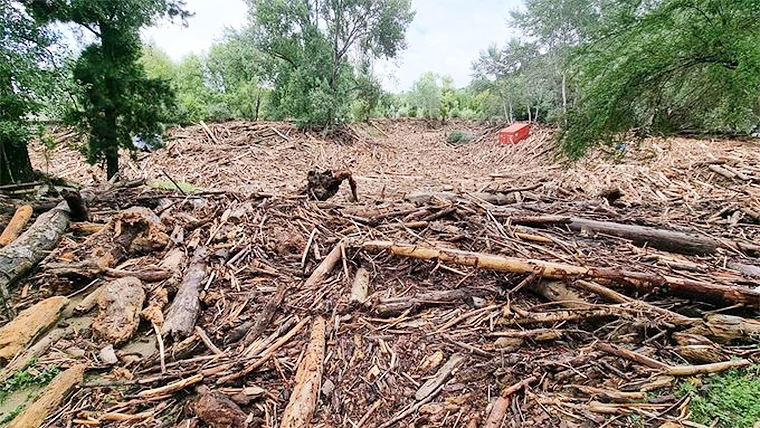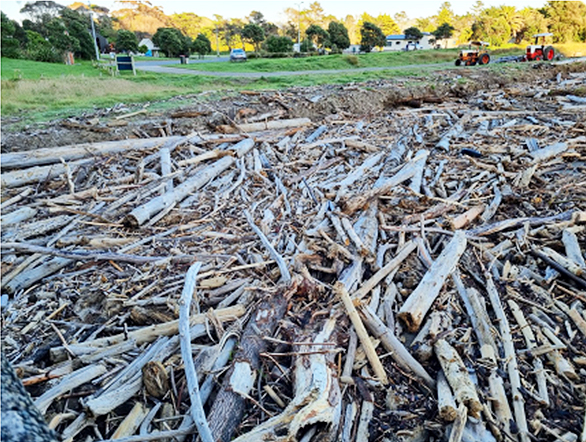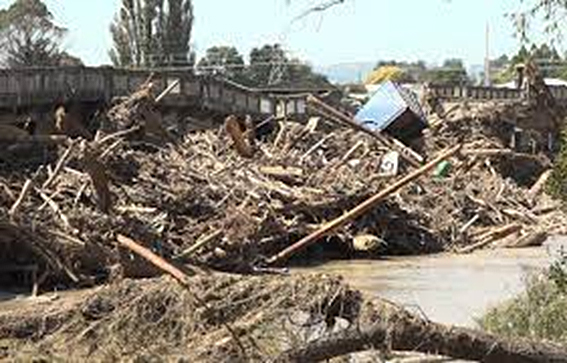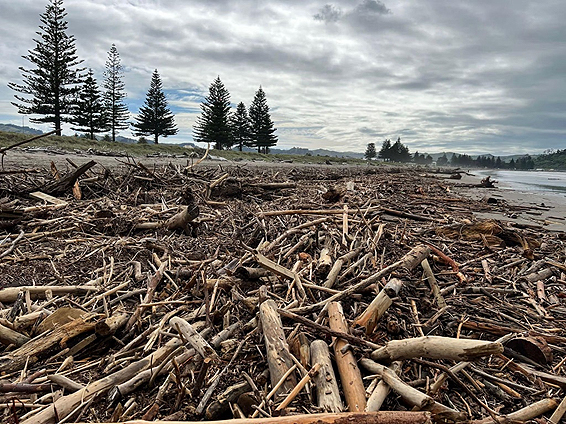
Last Friday “the ministerial inquiry into forestry slash” was released. The title of the report “Outrage to Optimism” provides the tone that is captured in the report.
At 44 pages (with comprehensive appendices to come at the end of this week) the report is succinct. However for the purposes of this article only the highlights and more important issues can be captured, and readers will need to go back to the links to fill in the gaps.
Hekia Parata fronted the release of the report at a press release and Q & A session and this makes good listening. Coincidentally this is also 44 minutes.
The general tenor of the report is that the three regions studied, Wairoa, Tairawhiti and the Ngati Porou East Coast have all been severely affected, but in particular the East Coast. The report provides 50 recommendations. It is worth noting that when the announcement of the review was made 10 weeks ago, the then Minister of Forestry Stuart Nash made the comment that government will not be not be bound by any recommendations; however he also added that they “would be taken seriously”.
The review agrees with others before them that the disaster has been years in the making.
It highlights that prior to Cyclone Gabrielle scientists had identified 864 gullies that were in need of attention, these ‘wounded’ gullies in Tairawhiti were responsible for over half of the silt and sediment coming into the waterways and yet make up only 2% of the total land area.
Roads were substandard and powerline infrastructure less than desirable, with the East Coast in particular subject to generations of depravation.
Along with forestry, past governments and the Gisborne District Council (GDC) came under their share of criticism. Although the report was not about attributing blame, it says that the relevant authorities did not provide adequate oversight of forestry activities and all parties actions lacked “common sense”.
GDC Mayor Stoltz was not happy with the review and is quoted as saying many of the claims were unsubstantiated.
However, Parata hit back saying that the evidence is plain to see and the appendices due out later this week provide accurate records of where the claims and evidence come from supporting her rebuttal.
When it comes to the cleaning up of the slash, the report recommends that forestry carry half of the cost as a means to working towards at least in part of restoring their social license to operate. For the region the report recommends the appointment of a Commissioner to oversee the implementation of the future RMA along with a Crown Facilitator who will combine the joint funding revenues that come into the regions and allocate according to priorities.
The key recommendations (in this writer's view) were:
R1. Establish a Woody Debris Taskforce to coordinate the clean-up, to de-risk catchment debris accumulations, and to plan for and respond to future events in Wairoa and Tairawhiti. This taskforce should prioritise employing the local workforce for clean-up work.
The government has responded with a fund to remove up to 70,000 tonnes of slash and debris from the review regions plus Hawke's Bay. It was interesting to note in the editorial footnotes in the above link showed that “The Hill Country Erosion Fund” (HCEF) which operates four-yearly contestable funding rounds had out of an approximate $24m fund had $930,000 allocated for the GDC region one of the lesser funded regions. Taranaki for instance receives $3.6m. This fund is not the ‘new’ fund allocated recently in response to Cyclone Gabrielle. The 70,000 tonnes of slash to be removed must be considered just a starting point as it will be soaked up rapidly by the vastness of the problem and of course future weather events which inevitably arrive will bring down yet more slash etc.
R8. Ensure the development of a full resilience plan for SH35 and SH2 in the region, and fully fund the plan in its entirety, separate from the National Land Transport Programme by the end of 2024. This is a major capital investment that will need specialist expertise to be procured and to be delivered (the Order in Council should be considered to set up this delivery model). The plan needs to include innovative design solutions and consideration of routes and large stabilisation works necessary to deliver resilience, and must integrate with the following resilience projects:…
It has taken up to this weekend to reopen SH2 between Wairoa (and Gisborne) with Hawkes Bay, be it via 10km per hr Ballie bridge.
R14. Direct the GDC to include land-use policy in its regional planning instruments to support a mosaic of sustainable land uses which reflect the characteristics of individual catchments.
This is rather than follow the large-scale tracts of single use (forestry) model currently applied. While not a recommendation the report does include:
35. The Minister of Finance should review the OIO decision to not carry over the condition of requiring a processing plant to be built as a condition of the purchase of Hikurangi Forest Farms. The Minister should also review the OIO decision allowing the Huiarua Station and Matanui Station to be sold and planted in exotic trees. They also said it was “extraordinary that companies that have convictions for environmental offences and are responsible for environmental and property damage and loss of social licence have maintained Forest Stewardship Council (FSC) certification”.
R22. Immediately restrict large-scale clear-felling of plantation forests in Tairawhiti and Wairoa, in favour of staged coupe harvesting.
This will impact upon the economics of forestry in some regions and the forestry companies’ responses will be ‘interesting’.
They also want the decision not to ‘force’ the setting up of another forestry processing plant in the region to be reviewed”
R30. Review the decision of the Overseas Investment Office not to carry over the condition that required a processing plant to be built as a condition of the purchase of Hikurangi Forest Farms.
Given that slash etc may now incur a greater economic cost this may help answer the need to ‘process’ this resource.
The impact that Maori in particular have endured from the past actions and inactions has resulted in some specific recommendations were made towards Maori and Maori owned land.
R33. Agree to partner with whenua Maori landowners in Tairawhiti and Wairoa in this proof of concept for a suite of investment-ready development projects, with co-investment sought through the East Coast Exchange, to transition to a mosaic of high value land use and biodiversity.
Under the “Economic” banner one of the more novel ideas, but one that should resonate with farmers and other land owners is:
R35. Direct the establishment of a world-leading biodiversity credit scheme to incentivise permanent indigenous forests, and the scheme should be piloted in the region.
Accepting that if forestry is more constrained in the future which may result in job losses (1 in 4 people employed in the GDC region are directly or indirectly involved with forestry) the authors recommend:
R39. Approve a Just Transition process for Tairawhiti, incorporating the following areas of focus:
R39.1. engaging in research and development to support alternative industry growth and land uses
R39.2. ensuring investment is directed toward new industries that will support the vision for the region
R39.3. ensuring the existing local workforce is well equipped and well supported to transition to new industries
Given some of the criticisms from forestry companies, and what have been queried as ‘veiled threats’ by some, the above recommendations may be seen as a recognition of a time when forestry does not hold as much clout over the Coast.
Much more could be written given the impacts and passions surrounding the cyclone events. It is worth noting that a key finding of the report is that concerted actions need to be taken in the very near future, and if the ‘healing’ does not take place then “irretrievable and widespread land collapse will occur". No doubt this will also spread into the waterways and the bays. Hopefully we will see all parliamentary parties show actions that largely support the report as most have come out saying they support it in principle.

Tolaga Bay Beach 2023.
Source: Outrage to Optimism Report.

Source: Te Ao Maori News

Source: NZ Herald
21 Comments
As an observer up close and personal, forest management in New Zealand is abhorrent. To get the damn things out to port I have never seen so much large machinery attack the landscape and brutally maul it. I never previously understood the costs involved either. My view of farming wood has changed. I would be interested to know just what the return on investment really is.
Maybe Belle, but the trees were put there to cut down, and more will be put there to cut down. The issue here is the slash. There was a time that the forestry companies just bulldozed it into large very long piles and burnt it. Problem solved. Until the greenies came along.
It aint just the slash. Our Nth island rivers are full of top soil - the stuff you grow things on. Slowly but surely the fertility is being washed out to sea.
You cannot take crop after crop of anything without it destroying the fertility. How many cycles of pine before the land is exhausted - have you thought that one through?
After a few cycles of pine we will be left with barren hills, no soils and just a few scrubby plants. Exposed barren hillsides that allow run off to bugga up the low lands and coast every time there is a down pour.
You got it rastus. We treat soil like some kind of sponge to be pumped full off fertilisers and weed killers, rather than a living thing.
There is no law against burning slash .
It makes great biomass to be burnt for industry or powerplants. Just needs the infrastructure to process on or near site to reduce transport costs , and coal to pay its true cost to make it viable.
completely impractical and uneconomic on every level.
Yet , scandavavia can do it , and ship it here , TheUSa exports shiploads to Europe.
Why is it uneconomic and impractical here?.
Safety & compliance ..... work in NZ's heavy industry and you'll see. Honest to god, someone tripped on stairs one day and fell down them injuring their hand. The safety brigrade went nuts, this shall be prevented !!! We can do this and this to prevent it from EVER happening again.... yea right lol
Why I work alone under the cover of darkness,lol.
I envision the processing would have to be highly mechanised and remote controlled/ automated to be economic, following on from logging so safety procedures are in place.
Topography, climate, location. Ever been into these remote hills? Steep, slip prone, isolated, unstable. Dragging low value (less) slash out of these areas would be futile, the cost far exceeding any gain.
Yes, I was on a logging operation last weekend. Your not getting all of it of course, but the majority is on the landing/ sorting area, which has road right to it
I guess I am wondering if the issue here is more than slash. Just the roading required to get the logs out of hill country is phenominal. I have been watching a block in the neighbourhood get logged. The truck and trailer to bring metal to put on said road hasnt stopped in months. So far the road is only around 2km. The whole thing is mindboggling. There are the two big bullies. A couple of diggers. The roller. The scavenge crew...I dont think thats the word...the crew that logs a wee bit so the roading can go ahead where the pines were in the way...well they come and go. Each time bringing the big harvesting machine and another machine that pulls logs up and out of spots where there is no road yet. Its all about as fuel hungry as you can get. Then there is the trip to port. I could go on...and on. In the meantime what was farmland 27 years ago is getting ripped and mauled. No wonder the coast got annihilated.
Yes, it is mind-boggling. And sure to be one of the key problems with the state highway network in the region. Too much of this logging traffic. It would be interesting to compare the weights of a fully loaded dairy tanker; a fully loaded stock truck; and a fully loading logging truck.
Any guesses?
Well, the logging trucks are likely 50T. I don't think stock truck sizes increased with the laws, so they're probably still under 40T (though someone more recently in the know can correct me). From the time I spoke to the forestry tuck line, if I recall aright, the colour of the paint numbers on the logs tells you what the carry load is.
We used to live on a LSB on a Highway, our road was rebuilt. Then the logging started, and boy do those guys destroy roads. Aside from the driving at 35km/h, never using byes, and covering the road for a good couple of kms from the gates in sludge (for which their solution was to put out a temporary 50kmh sign). Starting at 4am when their community notice said they'd start at 7am - we found out in that event that the forestry act doesn't have noise or time limits - so they can do what they want when they want with the community unable to take any enforcement action (short of an injunction, I guess).
Meanwhile, the losses are socialised and we all pay for the damage inflicted by the few.
Hopefully the lawyers will be all over this report and class action is being organised by the orchardists and others affected - negligence, causation, quantifiable damage, breach of statutory duty.
This could get interesting.
Good luck with that Rastus. Which did the damage? Slash or trees or just silt and rocks from the river beds? Or a combo of a couple or all? And on the slash, perhaps going back to burning it would sort out the problem.
There are precedent cases where the offending party has had to pay damages - call all it luck, if you want, I'd call it applying the law. Here's a few -
Allenby v Rotorua Lakes Council (2009); Hulton v Rotorua District Council (2004);Glenstrae Farms Ltd v Hastings District Council (2004).
Just requires the affected to get organised and take a case.
If you think it's not being considered - good luck to you.
"Will this latest forestry slash review be acted on?"
Given that it is a contest between vested interests, (overseas?) and the citizens of NZ. - Of course not.
Expect all the spin in the world, delaying tactics, distracting tactics, half measures and compromise. Anything but do anything meaningful and positive. (like every other issue plaguing NZ.)
So what's the solution ? You either burn it or you need the mother of all chippers and you chip the lot and leave it to rot, which it will very quickly. In the unlikely event it rains and you get slips then at least it doesn't build-up into some huge tangled mess that takes out bridges and piles that are hard to clear up. Not sure why you need a review on the issue, just make it law you need to clean it up.
Sounds like an excellent investigation and report. Here's hoping the recommendations are acted on. Driving around that coast from Gissy to Waihau Bay is an experience every NZer should do. But we have to keep the settlements viable/populated - because to my mind, tourism as the industry of note in the area is the way to go.
There is a way to deal with this AND reduce that pesky carbon problem.
Biomass burial is one of the most promising and uncharacteristically simple engineered approaches to removing carbon from the atmosphere.
Essentially bury it as woodchips = no slash problem
https://www.greenbiz.com/article/deceptively-simple-technology-carbon-r…

We welcome your comments below. If you are not already registered, please register to comment
Remember we welcome robust, respectful and insightful debate. We don't welcome abusive or defamatory comments and will de-register those repeatedly making such comments. Our current comment policy is here.